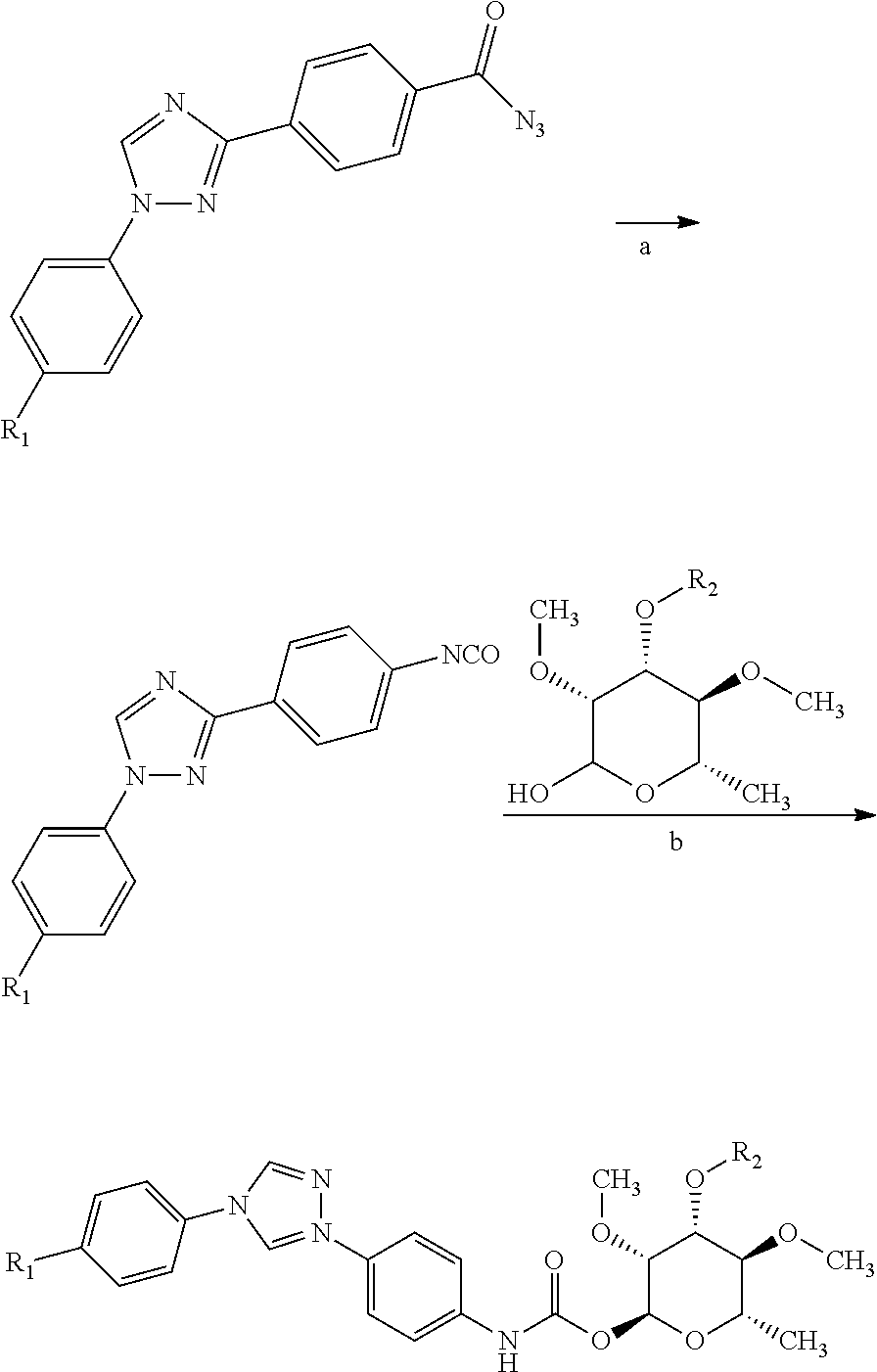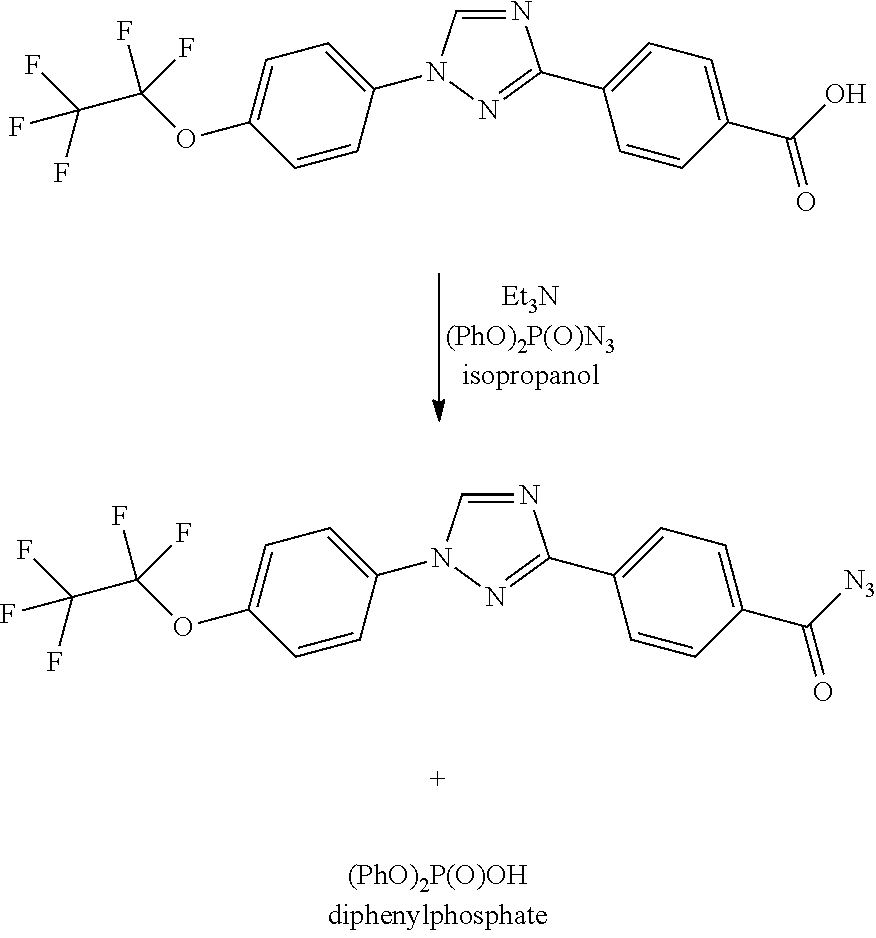Process for preparation of 4-(1-(4-(perfluoroethoxy)phenyl)-1H-1,2,4-triazol-3-yl)benzoyl azide
a technology of perfluoroethoxy and benzoyl azide, which is applied in the field of process for preparing 4(1(4(perfluoroethoxy)phenyl)-1h1, 2, 4triazol3yl) benzoyl azide, can solve the problems of difficult removal of diphenylphosphate from acyl azide, high cost of reagent, and limited research quantities
- Summary
- Abstract
- Description
- Claims
- Application Information
AI Technical Summary
Benefits of technology
Problems solved by technology
Method used
Image
Examples
example 1
on of 4-(1-(4-(perfluoroethoxy)phenyl)-1H-1,2,4-triazol-3-yl) benzoyl azide from mixed anhydride
[0066]
[0067]Into a 3-L, three-neck round bottom flask equipped with overhead stirrer, temperature probe, addition funnel, and nitrogen inlet, was added 4-(1-(4-(perfluoroethoxy)phenyl)-1H-1,2,4-triazol-3-yl) benzoic acid (100 g, 238 mmol) and tetrahydrofuran (550 mL). This gave a brown solution which was cooled to 9° C. and triethylamine (36.9 mL, 262 mmol) was added all at once. The temperature rose from 9° C. to 11° C. The solution was cooled back down to 1.4° C. and ethyl chloroformate (28.7 g, 25.3 mL, 262 mmol) was added drop wise over a 12 minute period. The mixture exothermed from 1.4° C. to 5.5° C., with the average addition temperature being 4.4° C. The mixture was allowed to stir for 30 minutes and assayed by LCMS (reaction complete). To the reaction mixture, at 0.3° C., was slowly added a solution of sodium azide (17.01 g, 262 mmol) in water (300 mL). The azide solution was add...
example 2
on of 4-(1-(4-(perfluoroethoxy)phenyl)-1H-1,2,4-triazol-3-yl)benzoyl chloride
[0068]
[0069]Into a 250 mL three-necked round bottom flask fitted with an overhead stirrer, nitrogen inlet, T-type J-Kem thermocouple, and reflux condenser was added 4-(1-(4-(perfluoroethoxy) phenyl)-1H-1,2,4-triazol-3-yl)benzoic acid (4.1 g, 10 mmol). To the solid was added dichloromethane (30 mL). This gave a white suspension. To the suspension was added thionyl chloride (5.8 g, 49 mmol). This gave a white suspension and the mixture exothermed slightly from 19° C. to 22° C. over 5 minutes. The mixture was heated to 40° C. with a heating mantle for 3 hours then allowed to cool to 23° C. for 16 hours. This gave an off-white suspension. The mixture was transferred to a 500 mL rotary evaporation flask and rotary evaporated (24-95° C., 50 mmHg, 1 hour) providing the title compound as a tan solid (4.7 g, 108% mass balance). The solid is soluble in tetrahydrofuran and dimethylformamide and partially soluble in ac...
example 3
on of 4-(1-(4-(perfluoroethoxy)phenyl)-1H-1,2,4-triazol-3-yl) benzoyl azide from Acid Chloride
[0070]
[0071]Into a 250 mL three-necked round bottom flask fitted with an overhead stirrer, nitrogen inlet, T-type J-Kem thermocouple, and addition funnel was added 4-(1-(4-(perfluoroethoxy) phenyl)-1H-1,2,4-triazol-3-yl)benzoyl chloride (4.0 g, 10 mmol). To the solid was added acetone (50 mL). This gave a tan suspension. The tan suspension was cooled to 2° C. in an ice bath and an aqueous solution of sodium azide (0.75 g, 11 mmol) in water (10 mL) was added drop wise (caution: exotherm) over 15 minutes being careful to keep the internal temperature below 6° C. During the addition, the reaction exothermed from 2° C. to 6° C. This gave a white thick suspension. The suspension was stirred at 2° C. for 2 hours. Analysis by LCMS indicated the reaction was done. The reaction was diluted with water (100 mL) and stirred at 5° C. for 1 hour. The solids were collected by vacuum filtration and rinsed ...
PUM
| Property | Measurement | Unit |
|---|---|---|
| temperature | aaaaa | aaaaa |
| temperature | aaaaa | aaaaa |
| temperature | aaaaa | aaaaa |
Abstract
Description
Claims
Application Information
 Login to View More
Login to View More - R&D
- Intellectual Property
- Life Sciences
- Materials
- Tech Scout
- Unparalleled Data Quality
- Higher Quality Content
- 60% Fewer Hallucinations
Browse by: Latest US Patents, China's latest patents, Technical Efficacy Thesaurus, Application Domain, Technology Topic, Popular Technical Reports.
© 2025 PatSnap. All rights reserved.Legal|Privacy policy|Modern Slavery Act Transparency Statement|Sitemap|About US| Contact US: help@patsnap.com



